IGCSE Physics Past Years Exam Questions: Magnetism and electromagnetism 2023-24
We analysed the International GCSE past papers and grouped the questions by topic. Here, you will find questions relating to the topic – Magnetism and electromagnetism. Use these to familiarise, practice and prepare for your IGCSE Physics examination.
For more past year questions in the topic of Magnetism and Electromagnetism see below:
- IGCSE Physics Past Years Exam Questions: Magnetism and electromagnetism 2019-2020
- IGCSE Physics Past Years Exam Questions: Magnetism and electromagnetism 2021-2022
What you need to know
Use the list below as a quick recap for what you need to know before attempting the past year exam questions under this topic. This is based on Edexcel International GCSE in Physics (4PH1) specification with first teaching Sept 2017 and first examination June 2019.
Paper 1 and 2: (6) Magnetism and electromagnetism
Paper 1 covers all the topics except where it is marked “Paper 2 only” while Paper 2 covers all topics.
A. Units
- ampere (A), volt (V) and watt (W)
B. Magnetism
- know that magnets repel and attract each other and attract magnetic substances
- be able to describe the properties of magnetically hard and soft materials
- understand the term magnetic field line
- know that a magnetic field can induce magnetism in some materials
- investigate magnetic field patterns
- how to use two bar magnets to produce a uniform magnetic field
C. Electromagnetism
- know that an electric current in a conductor produces a magnetic field around it
- describe the construction of electromagnets (Paper 2 only)
- draw magnetic field patterns for a straight wire, flat circular coil and solenoid when each is carrying a current (Paper 2 only)
- know that there is a force on a moving charged particle in a magnetic field (Paper 2 only)
- understand why a force is exerted on a current-carrying wire in a magnetic field, and how this effect is applied in dc motors and loudspeakers
- use the left hand rule to predict the direction of the resulting force when a wire carries a current perpendicular to a magnetic field
- describe how the force on a current-carrying conductor in a magnetic field changes with the magnitude and direction of the field and current
D. Electromagnetic Induction
- know that a voltage is induced in a conductor or coil when it moves through a magnetic field or when a magnetic field changes through it and describe the factors that affect the size of the induced voltage
- describe the generation of electricity by the rotation of a coil within a magnetic field or rotating magnet in a coil
(Paper 2 only)
- describe the construction of a transformer, and understand that a transformer changes the size of an alternating voltage. (Paper 2 only)
- explain the use of step-up and step-down transformers in the large scale transmission of electrical energy. (Paper 2 only)
- relationship between input and output voltages and the turns ratio for a transformer. input (primary) voltage/ output (secondary) voltage = primary turns/secondary turns (Paper 2 only)
- relationship input power = output power Vp Ip =Vs Is for 100% efficiency (Paper 2 only)
January 2023 Paper 1P Q2
2 Diagram 1 shows the magnetic field between the poles of two strong bar magnets.

(a) Add labels to diagram 1 to show the poles of the bar magnets. (1)
(b) The bar magnets are made from steel.
Give one reason why steel is a good material for making bar magnets. (1)
(c) Explain how diagram 1 shows a uniform magnetic field. (2)
(d) Diagram 2 shows a metal wire being moved downwards through the uniform field between the poles of the same bar magnets. The orientation of the magnets has not been changed.
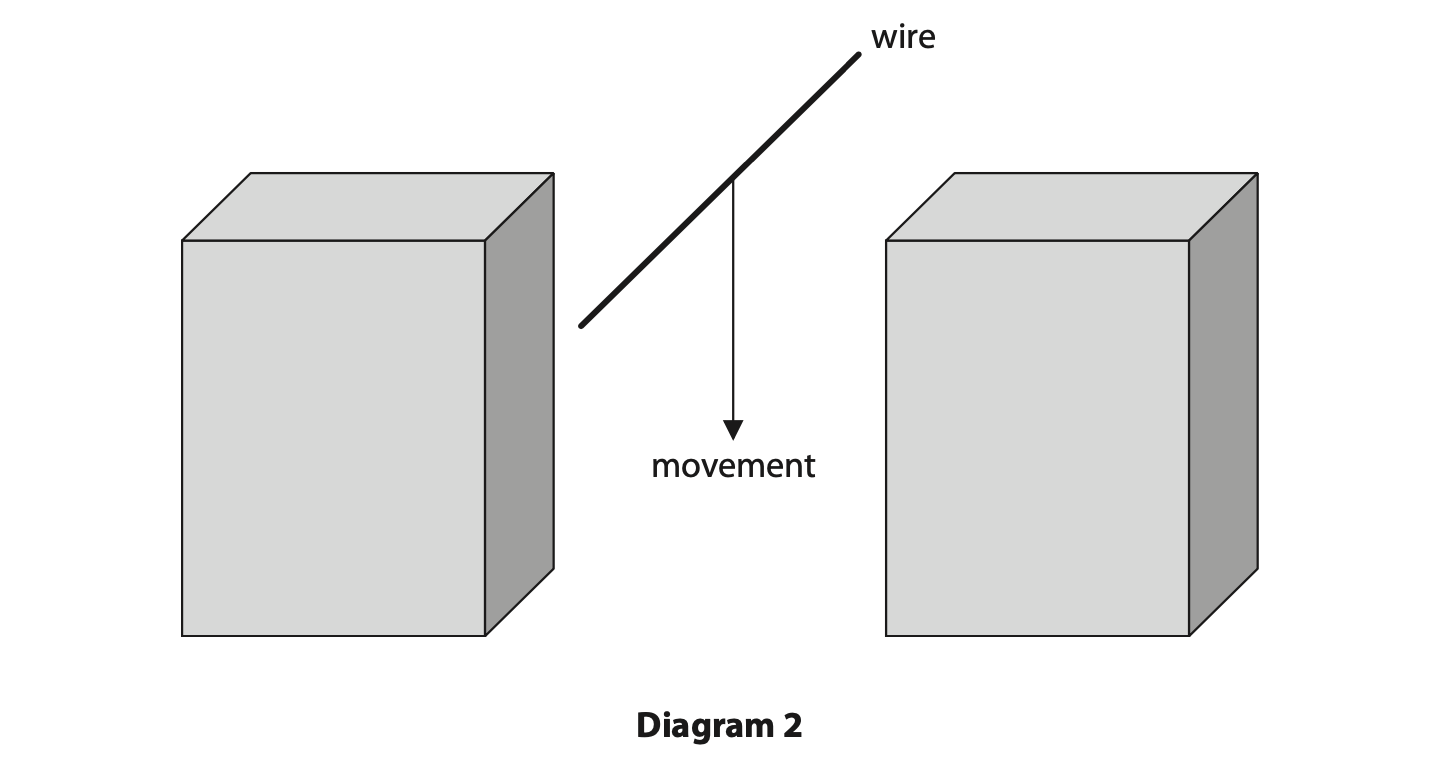
(i) Give a reason why a voltage is induced between the ends of the metal wire as it moves between the poles of the bar magnets. (1)
(ii) State two changes that could be made to this arrangement that would increase the magnitude of the induced voltage. (2)
(Total for Question 2 = 7 marks)
January 2023 Paper 1PR Q11
11 The diagrams show some equipment that the physicist Ørsted used in an investigation in 1820.
Diagram 1 shows the position of eight compass needles around a wire with no current in the wire.
The compass needles line up with and show the direction of the Earth’s magnetic field lines.
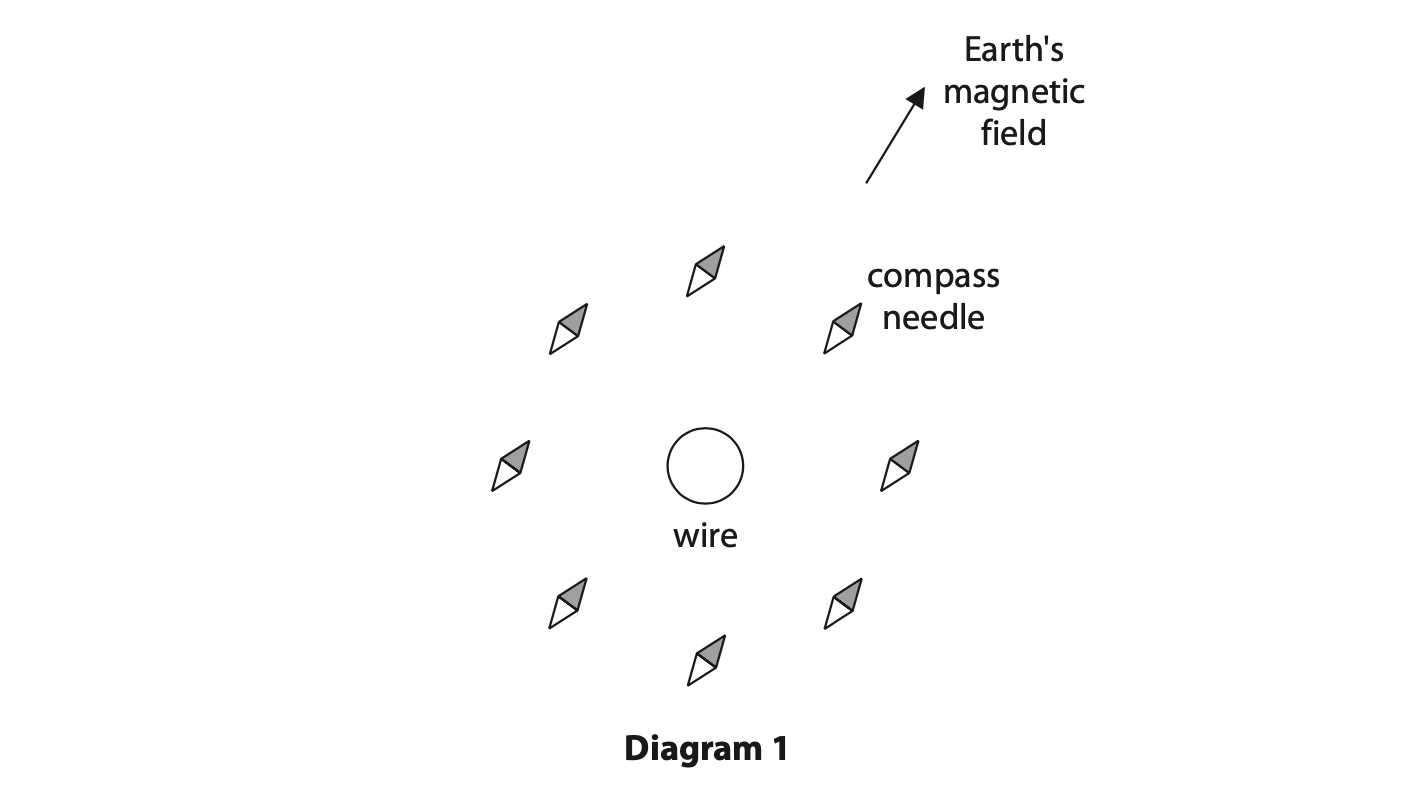
Diagram 2 shows the position of the same compass needles when a current is in the wire.
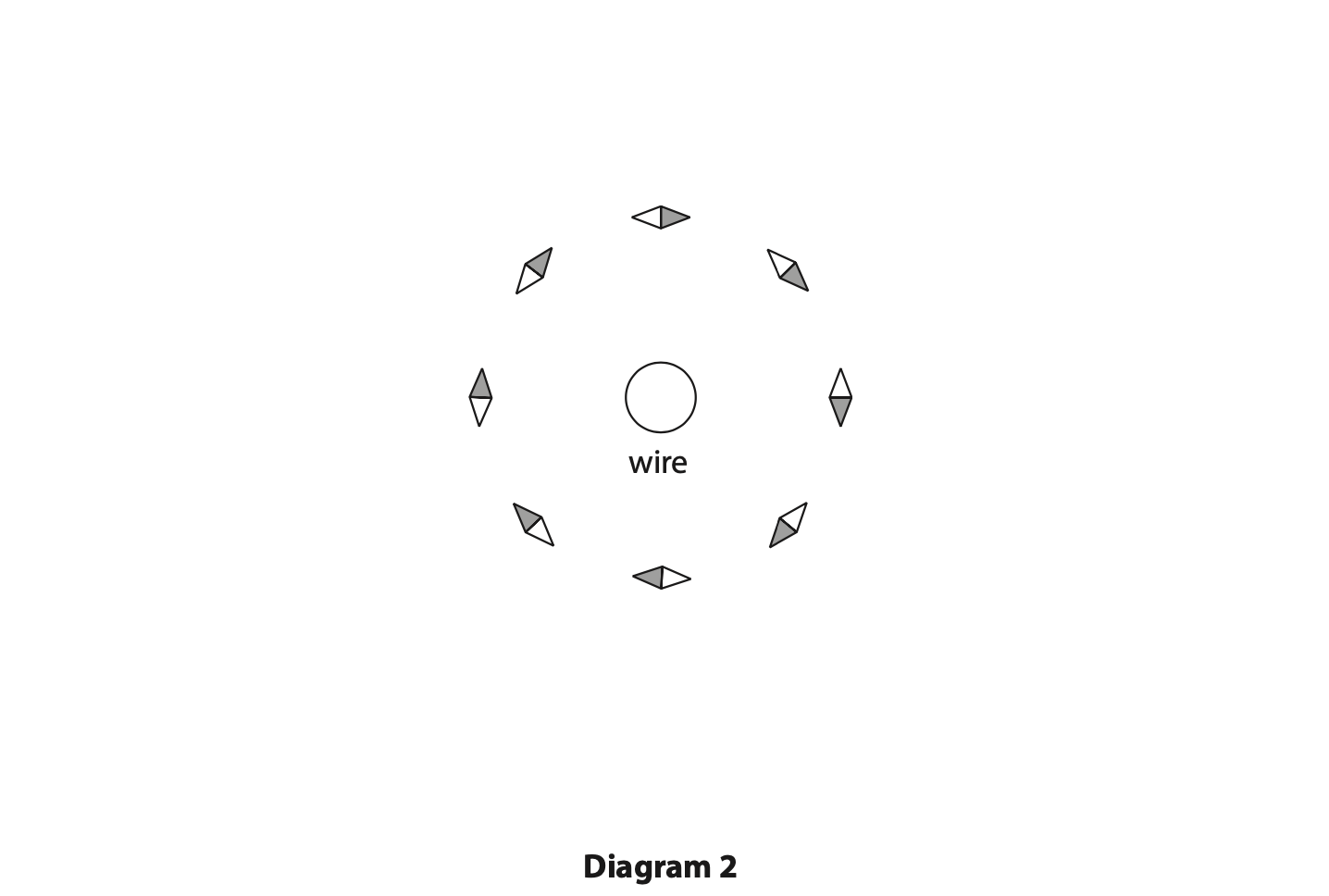
a) (i) Explain why the compass needles turn when the current is switched on. (2)
(ii) Using evidence from the compass needles in diagram 2, draw on diagram 2 the shape and direction of a magnetic field line produced by the current in the wire. (2)
(iii) Suggest what happens to the magnetic field when the current in the wire is reversed. (1)
(b) The current in the wire is turned off.
Diagram 3 shows the wire placed in a uniform magnetic field.
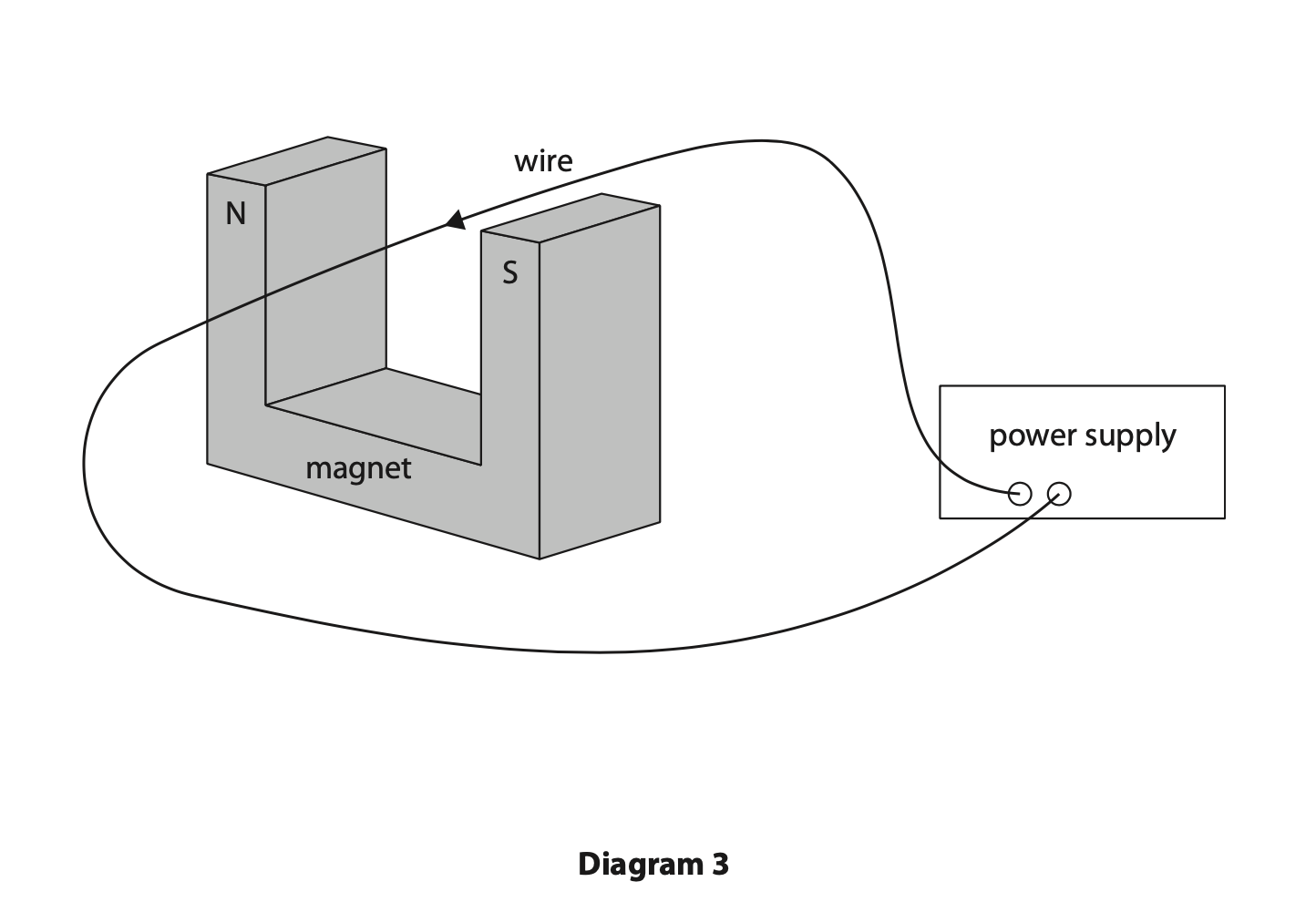
The current is now switched on.
Draw an arrow to show the direction of the force on the wire. (2)
(c) The power supply in diagram 3 is replaced by an ammeter.
(i) When the wire is moved, a current is detected.
Explain which direction the wire is moved in the magnetic field to produce a current in the wire. (2)
(ii) Explain why a current is produced in the wire when the wire is moved in the magnetic field. (2)
(Total for Question 11 = 11 marks)
January 2023 Paper 2P Q6
6 This question is about magnetic fields.
(a) A student positions a thick wire vertically through the centre of a horizontal card.
The student then passes a constant current through the wire in the downward direction, as shown in diagram 1.
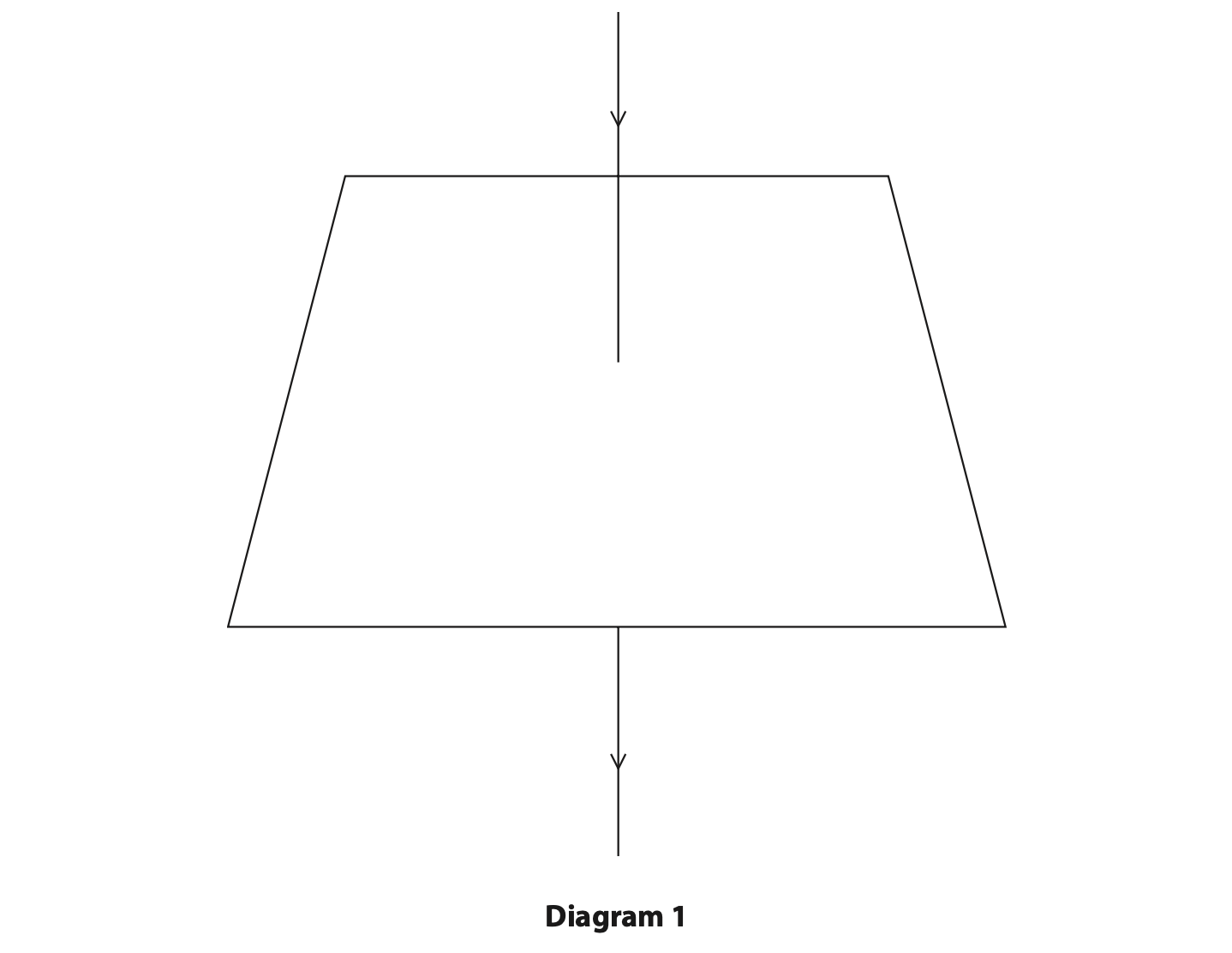
(i) On diagram 1, draw the shape and direction of the magnetic field produced by the current in the wire. (3)
(ii) Describe a method the student could use to show the shape of the magnetic field produced by the current in the wire. (2)
(b) The student then removes the card and sets up a second wire next to the first wire, as shown in diagram 2.
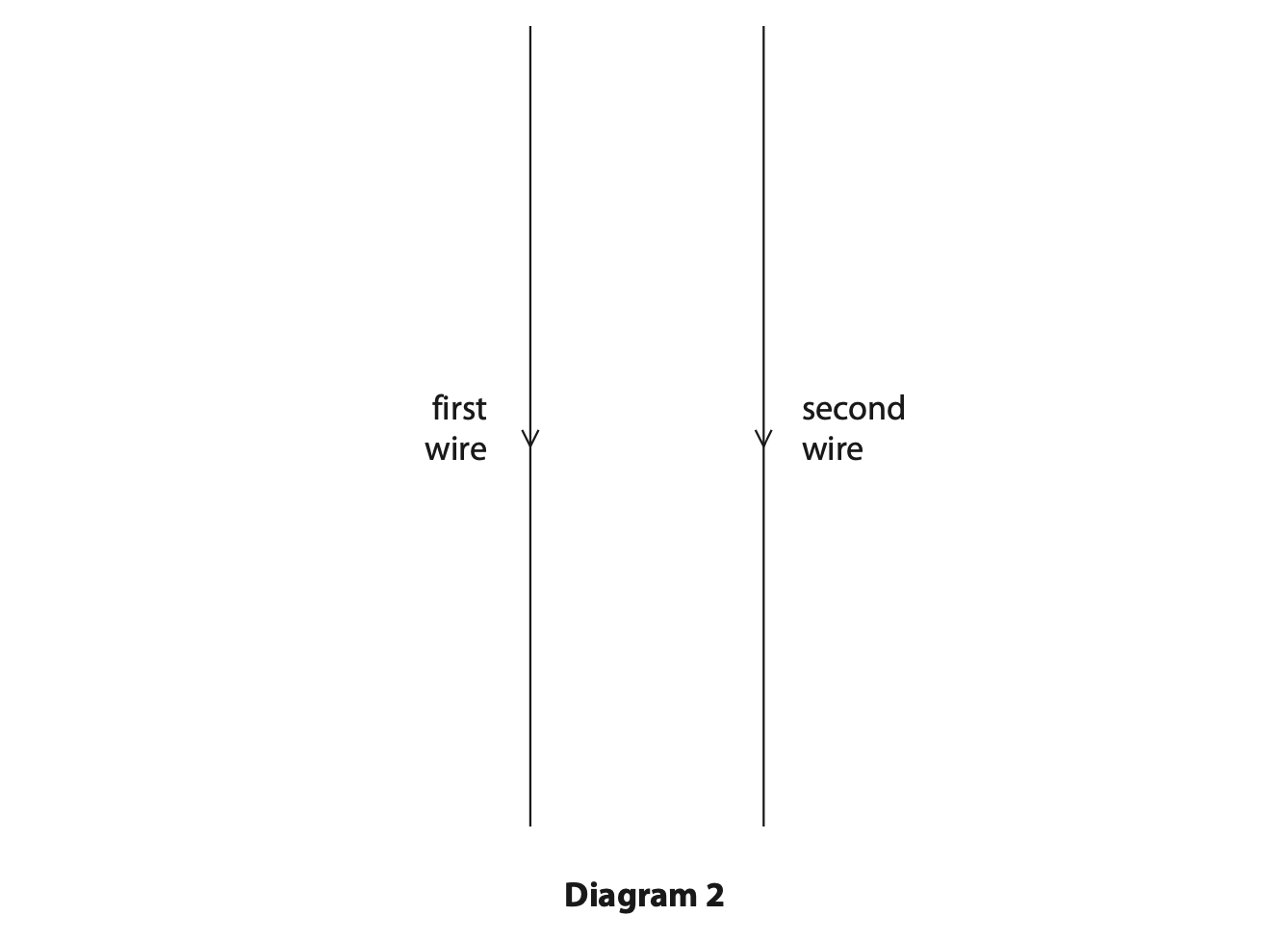
The current in both wires is in the downward direction.
The student observes that the wires move towards each other.
Explain why the wires move towards each other. (3)
(Total for Question 6 = 8 marks)
January 2023 Paper 2PR Q5
A transformer is used to charge a mobile phone. The diagram shows a label on the transformer.
input voltage: 230V input current: 0.067 A output voltage: 5.0V output current: 3.1 A |
(a) Explain how the information in the label shows that the transformer is a step‐down transformer. (2)
(b) Show that the transformer is approximately 100% efficient. (3)
(c) (i) State the formula linking input voltage, output voltage and turns ratio for a transformer. (1)
(ii) The primary coil has 1500 turns.
Calculate the number of turns on the secondary coil. (3)
turns on secondary coil = ……………………………………………………..
(Total for Question 5 = 9 marks)
June 2023 Paper 1P Q12
12 A device called a metal detector can be used to find metal buried underground.
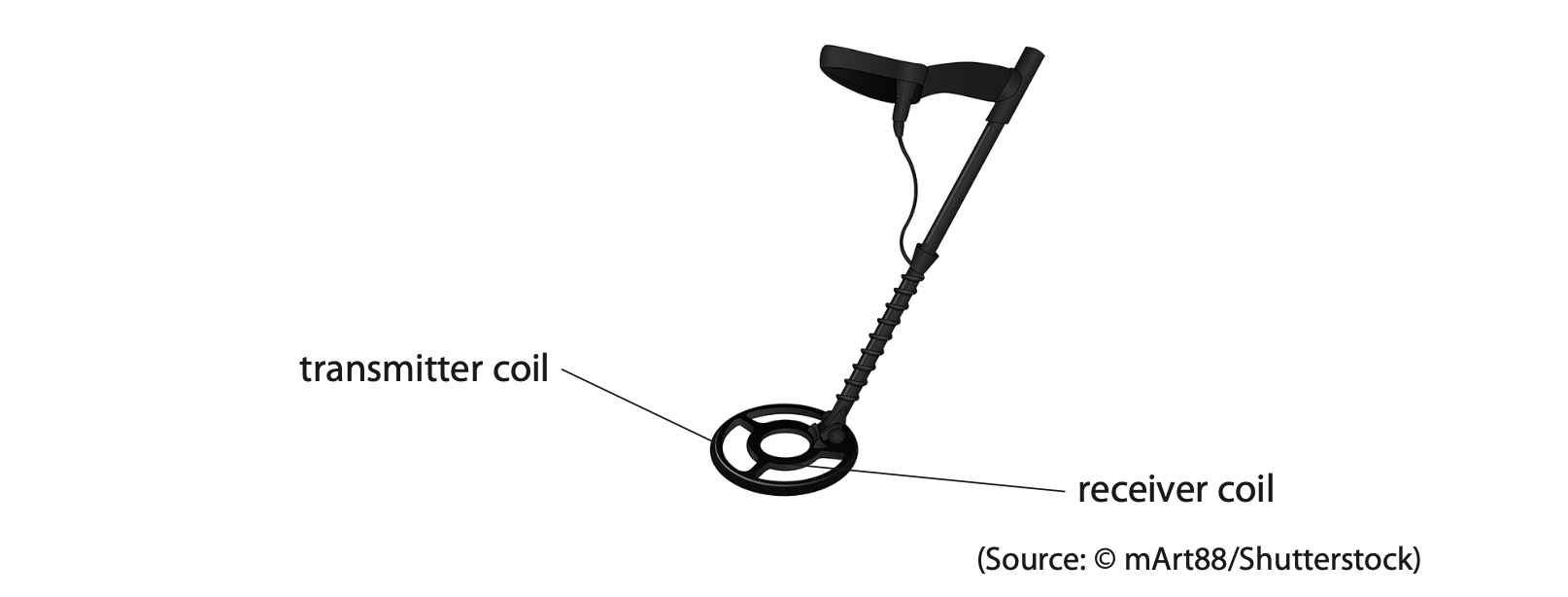
The metal detector has two circuits, each containing a coil of copper wire.
Diagram 1 shows the circuit for the transmitter coil.
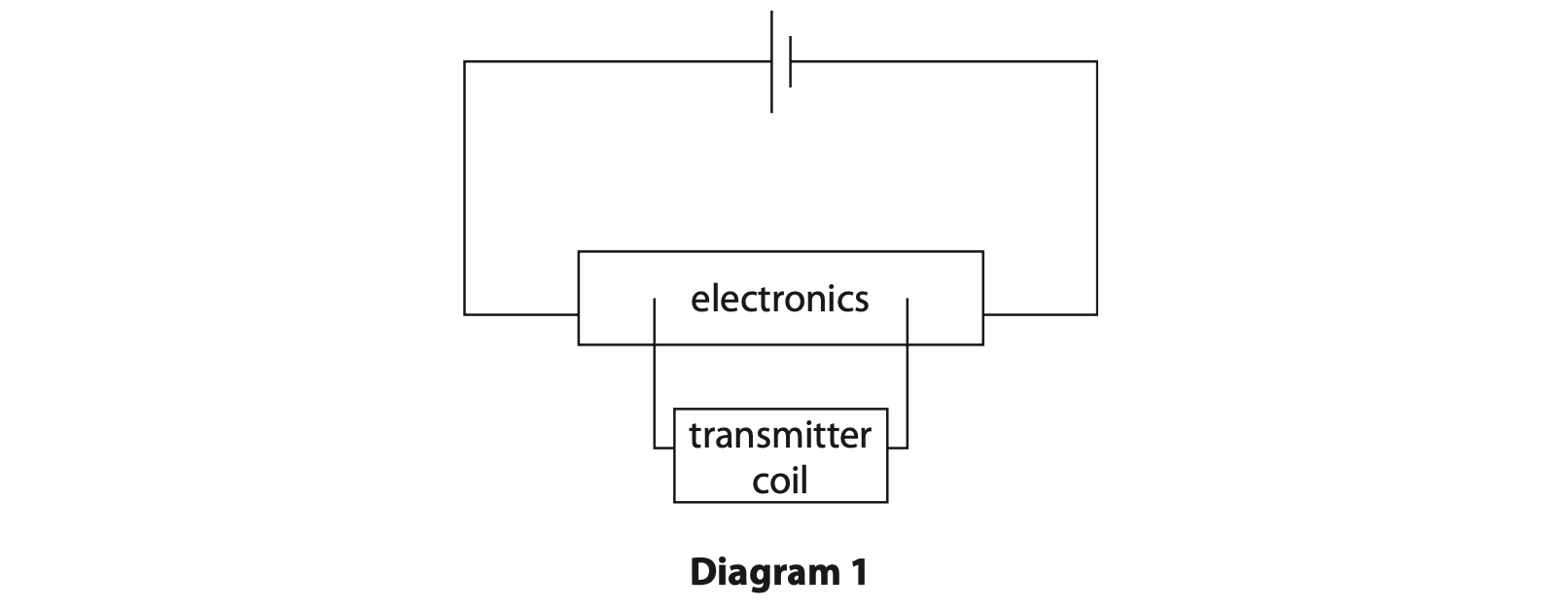
(a) Suggest why there is a magnetic field around the transmitter coil. (1)
(b) The cell supplies direct current (d.c.). The electronics in diagram 1 change the direct current into alternating current (a.c.) in the coil.
(i) Describe the difference between direct current (d.c.) and alternating current (a.c.). (2)
(ii) Alternating current is supplied to the transmitter coil.
Diagram 2 shows a gold ring in the soil below the metal detector.
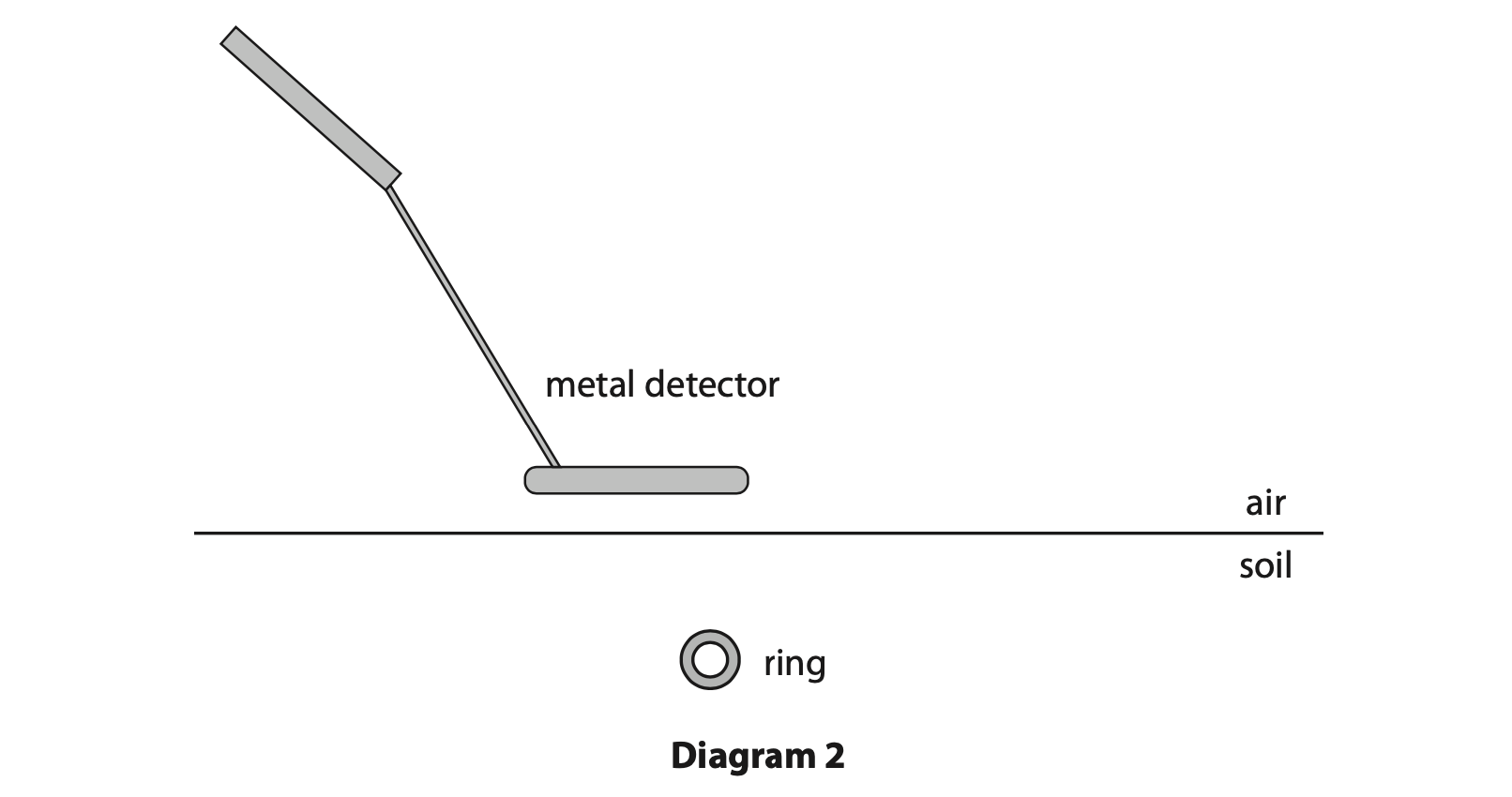
Explain why there is an alternating current in the gold ring. (3)
(c) Diagram 3 shows the circuit for the receiver coil.

As a result of the alternating current in the gold ring, there is an alternating current in the receiving coil.
Explain how an alternating current in the receiving coil causes a sound to be emitted from the loudspeaker. (4)
(Total for Question 12 = 10 marks)
June 2023 Paper 1PR Q4
4. This question is about magnets.
(a) Which of these substances is not attracted to a bar magnet?(1)
A cobalt
B copper
C iron
D nickel
(b) Diagram 1 shows a bar magnet.
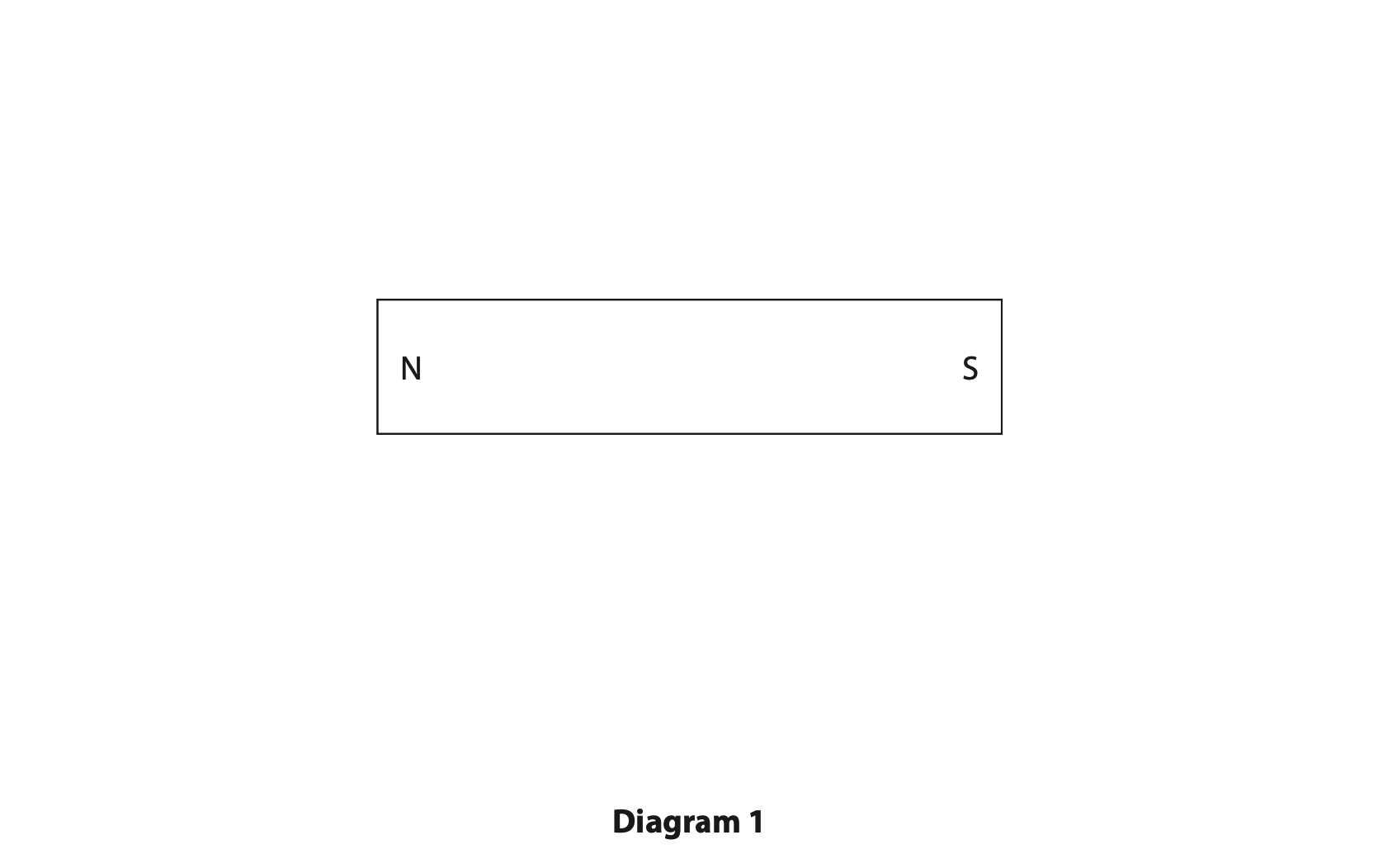
Draw magnetic field lines on diagram 1 to show the shape and direction of the magnetic field around the bar magnet. (3)
(c) Some bar magnets are made of steel.
Explain why steel is a good material for making bar magnets. (2)
(d) Diagram 2 shows a cross-section through a wire placed between two magnetic poles.
The direction of the current in the wire is out of the page.
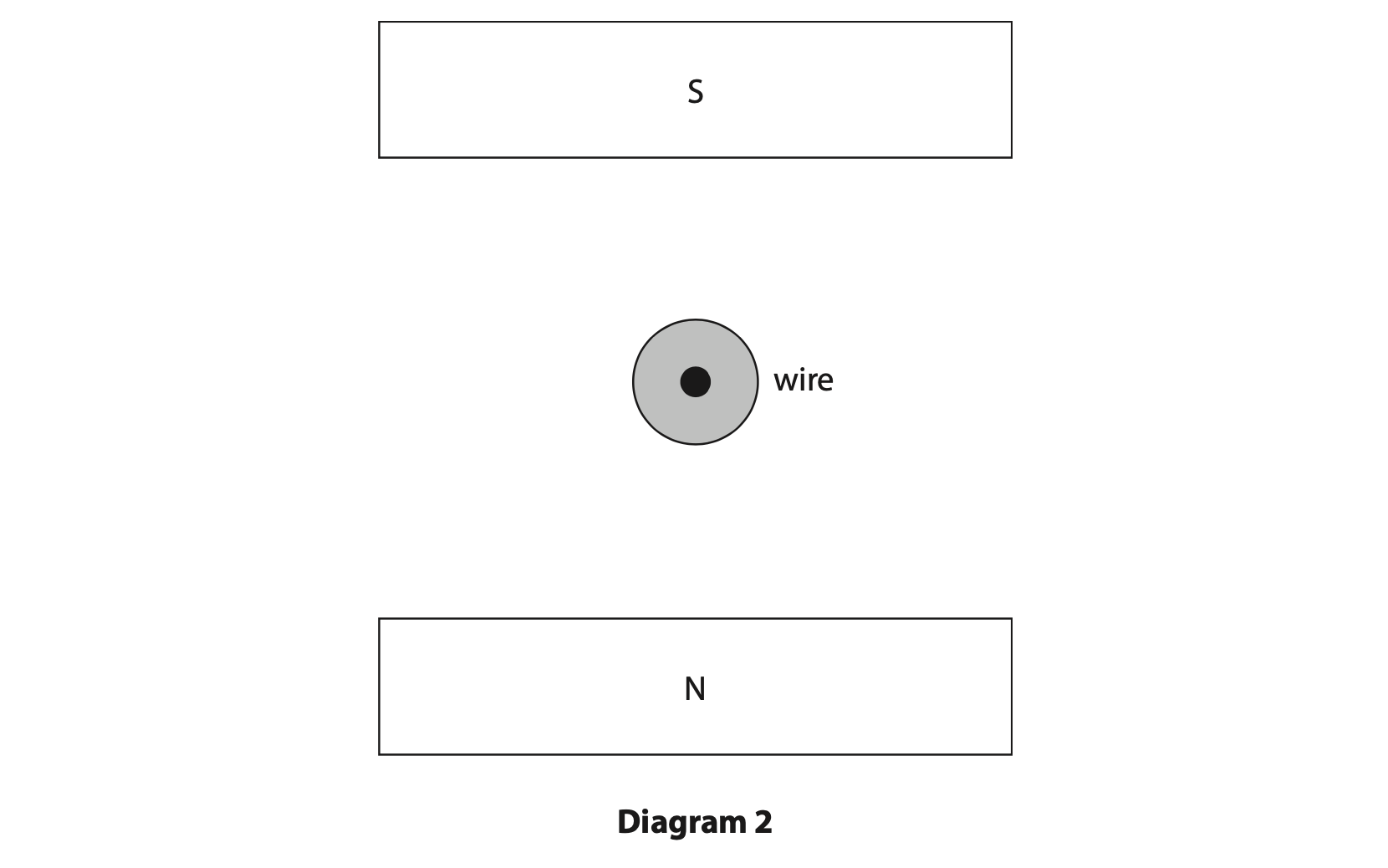
(i) Draw an arrow on diagram 2 to show the direction of the force on the wire due to the magnetic field.
Assume that the magnetic field is uniform. (2)
(ii) State two changes that could be made that would decrease the magnitude of the force on the wire in diagram 2. (2)
1
2
(Total for Question 4 = 10 marks)
June 2023 Paper 2PR Q6
6 This question is about electromagnetism.
(a) Diagram 1 shows the magnetic field around a straight section of copper wire.

Explain why the copper wire has the magnetic field shown in the diagram. (2)
(b) A student investigates how the strength of an electromagnet varies with the current in the electromagnet.
The diagram shows their apparatus.
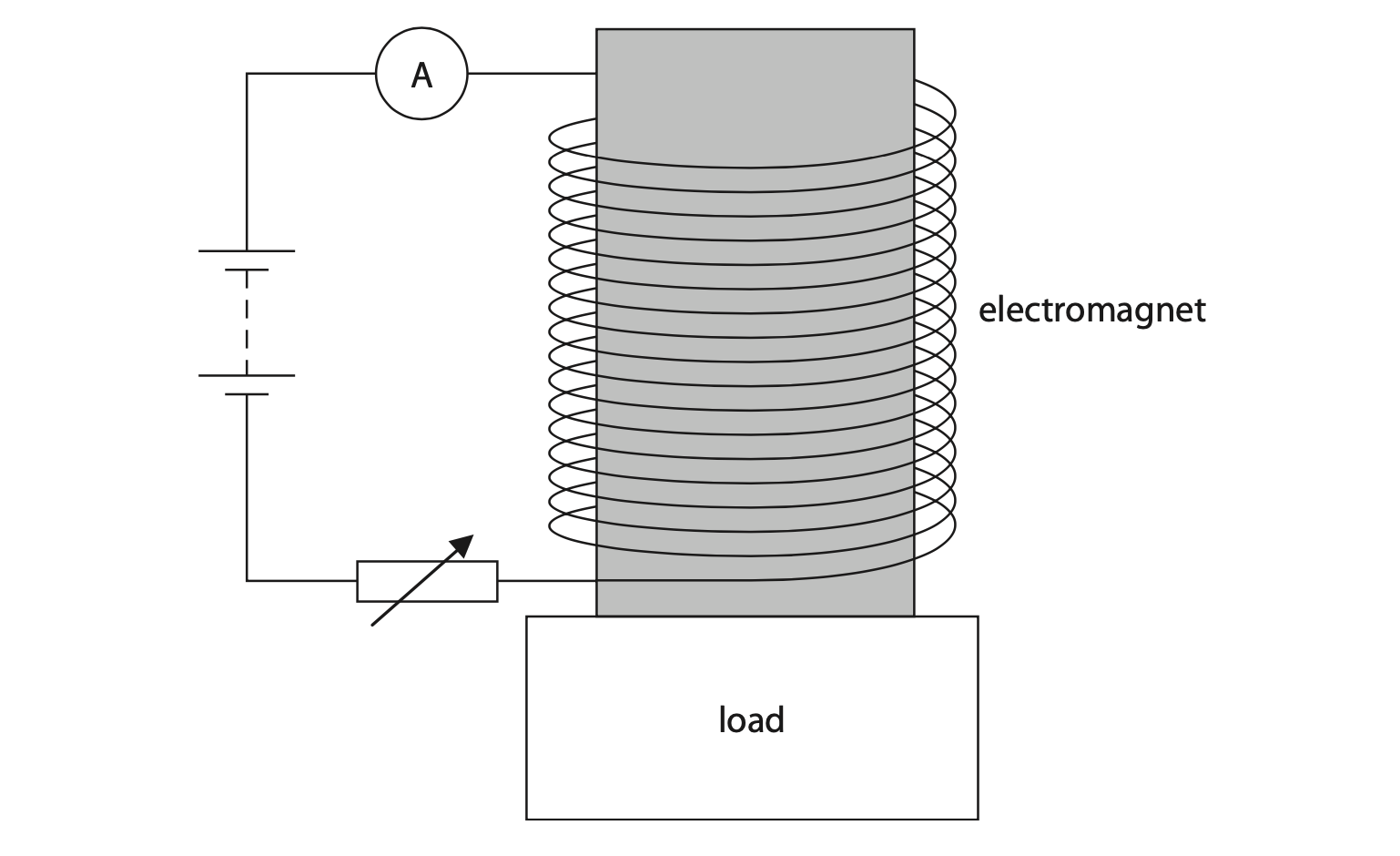
This is the student’s method.
- switch on the electromagnet at its maximum current
- place a load of 100 g so that it is held above the floor by the electromagnet
- slowly reduce the current in the electromagnet until the load falls from the electromagnet
- record the current at which the load falls
- record the current at which the same load falls two more times Repeat the method for loads of different masses.
(i) Suggest a suitable safety precaution for the student’s investigation. (1)
(ii) The table shows the student’s results.
| Mass of load in g | Current at which the load falls in A | |||
| 1 | 2 | 3 | Mean | |
| 100 | 0.28 | 0.31 | 0.31 | 0.30 |
| 200 | 0.60 | 0.57 | 0.57 | 0.58 |
| 300 | 0.91 | 0.90 | 0.86 | 0.89 |
| 400 | 1.19 | 1.23 | 1.27 | 1.23 |
| 500 | 1.45 | 1.57 | 1.48 | 1.50 |
| 600 | 1.79 | 1.84 | 1.87 | |
Calculate the mean current when the mass of the load was 600 g. Give your answer to a suitable number of significant figures. (2)
mean current = …………………………………………………….. A
(iii) On the grid, plot a graph of the mean current against the mass of the load. The scale for the mass axis has been done for you. (3)
(iv) Draw the line of best fit. (1)

(v) The student predicts that a load of 1.0 kg will fall when the current in the electromagnet is 3.0 A.
Comment on the student’s prediction. (3)
(Total for Question 6 = 12 marks)
November 2023 Paper 1P Q9
This question combines Radioactivity and particles & Magnetism and Electromagnetism
9 Diagram 1 shows some of the stages of electricity generation in a nuclear power station.
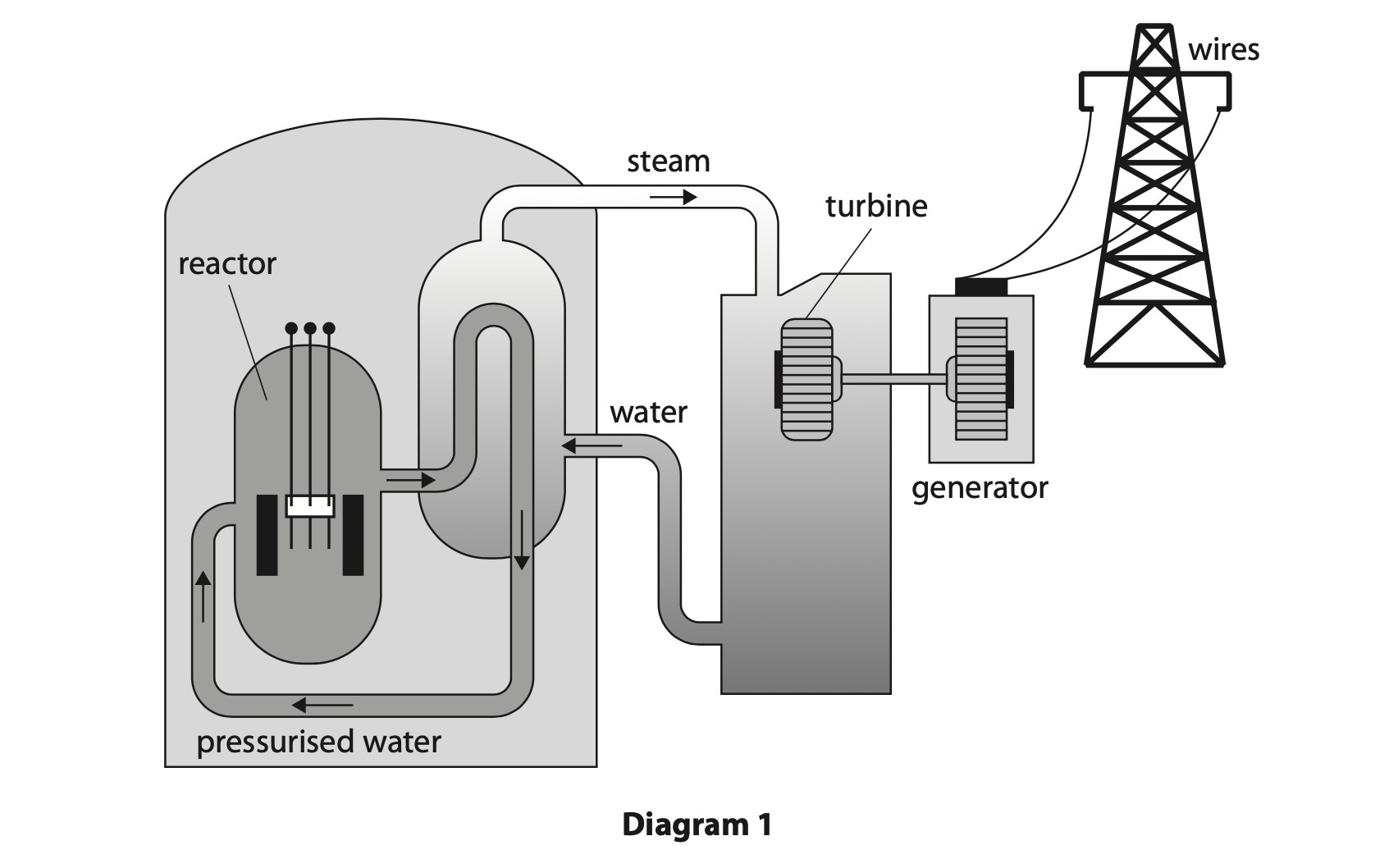
(a) Nuclear fission takes place inside the reactor of the nuclear power station.
(i) Give the name of a fuel that could be used in the reactor. (1)
(ii) Energy is released from the fuel in the reactor by nuclear fission.
Describe the process of nuclear fission that takes place inside the reactor. (4)
(b) High pressure steam transfers energy from the reactor to a turbine.
The turbine spins as the steam passes through it.
Diagram 2 shows a simplified generator connected to the turbine.
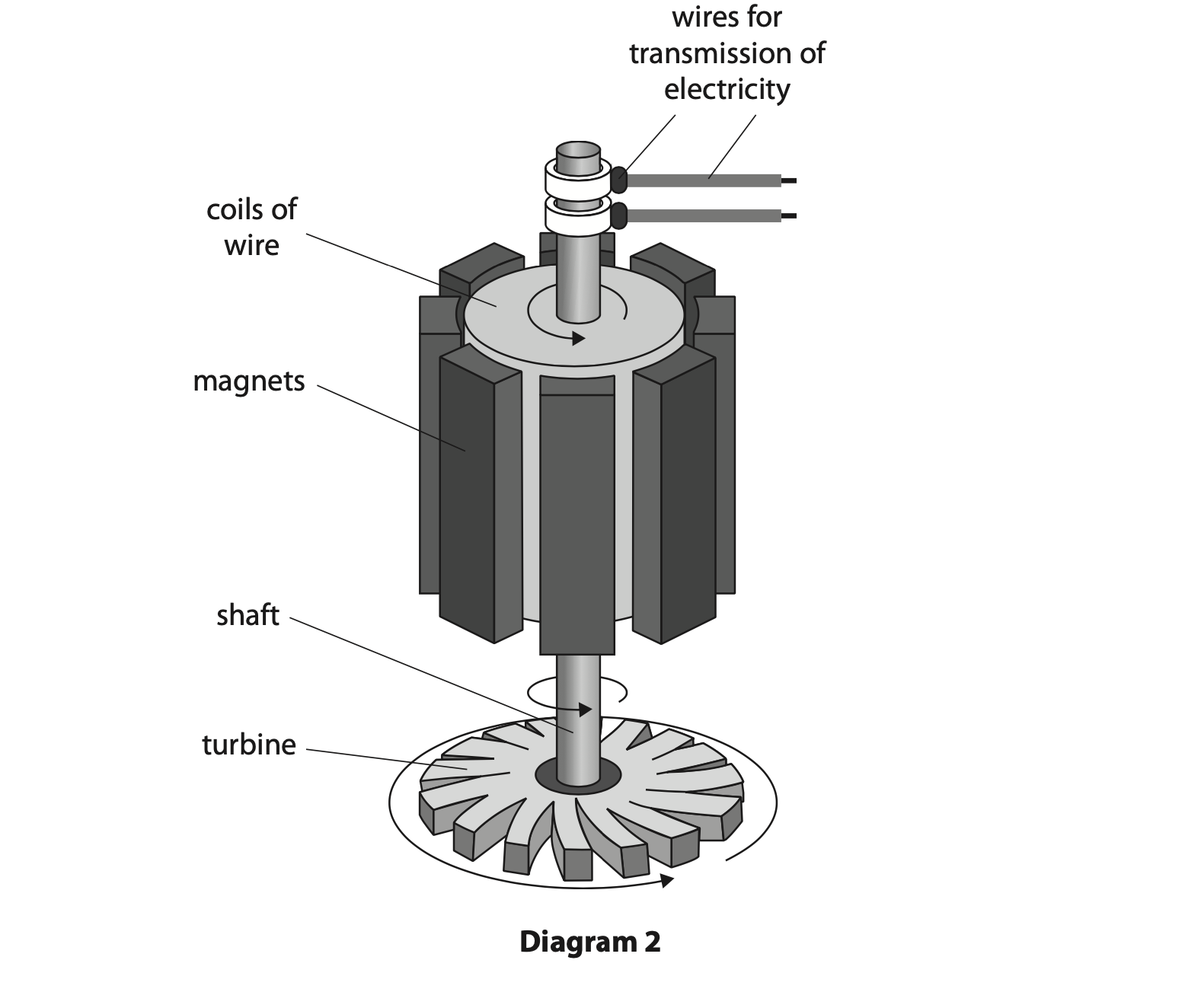
(i) Explain how electricity is generated by the generator. (3)
(ii) At night the power station does not need to generate as much electricity.
Suggest how the output of this generator could be reduced. (1)
(iii) The generator produces alternating current.
Describe the differences between alternating current (a.c.) and direct current (d.c.). (2)
(Total for Question 9 = 11 marks)
November 2023 Paper 2P Q4
4 The diagram shows a step-down transformer.
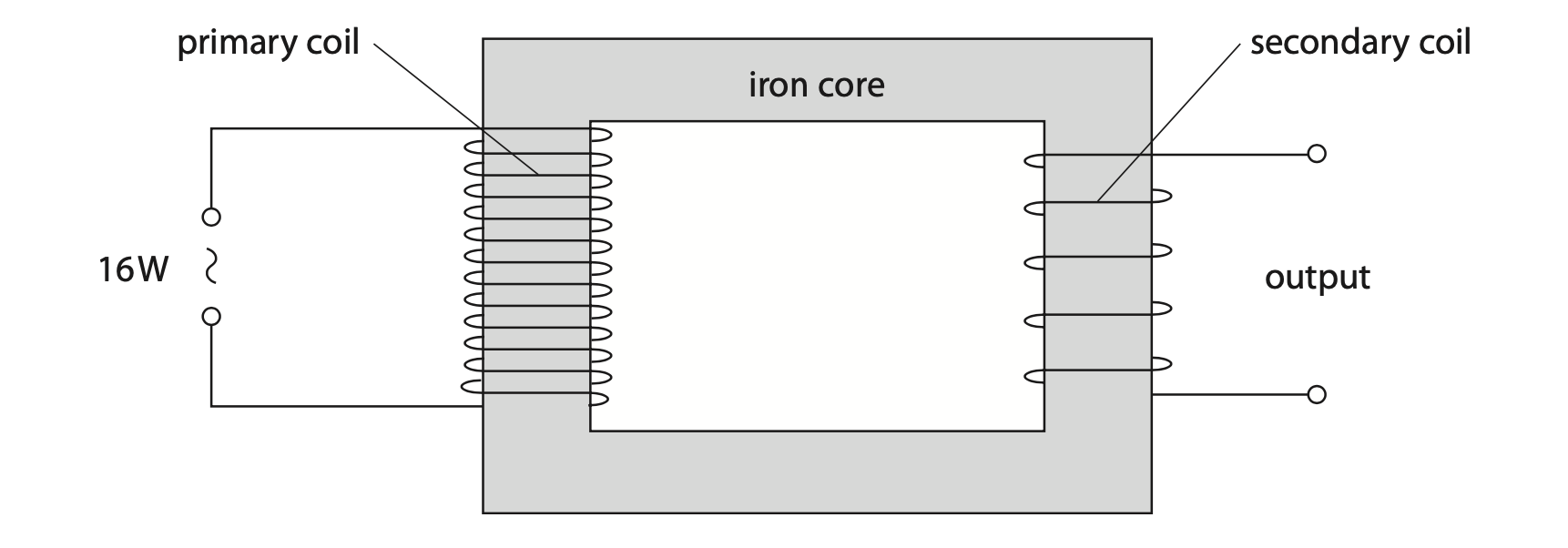
(a) The input power to the transformer is 16W.
The transformer is used for 2.5 hours.
Calculate the energy transferred to the transformer during this time. (3)
energy transferred = …………………………………………………….. J
(b) Explain how a transformer works.(6)
In your answer, include reasons for using
- two coils
- the iron core
- an a.c. power supply
(c) State how the primary coil of the transformer can be changed to increase the output voltage. (1)
(Total for Question 4 = 10 marks)









